Punishment Systems Comparison: Global Models, Practices & Outcomes
Updated On: October 23, 2025 by Aaron Connolly
Key Models of Punishment Systems
Countries handle crime in a few main ways. Some push harsh penalties to make offenders pay, others try to change behaviour with treatment, and a growing number aim to repair harm for victims and communities.
Punitive Approaches
Punitive systems make offenders suffer for their crimes. The United States stands out for its tough sentences and massive prison population.
Key features include:
- Long prison sentences
- Three-strike laws for repeat offenders
- Death penalty in some places
- Few programmes for behaviour change
Between 1980 and 2020, politicians in the US pushed for “tough on crime” laws, which caused a 500% jump in prison numbers.
Punitive models rely on two ideas. Retribution means making offenders pay society back. Deterrence tries to scare others away from crime by showing what happens if you break the law.
Running these systems costs a fortune. They also deal with high recidivism—a lot of people return to crime after release because they never really changed.
Rehabilitative Approaches
Rehabilitative systems focus on changing offenders so they don’t reoffend. Norway really leads here, with prisons that look more like dorms and focus on therapy and education.
Common programmes include:
- Job training and education
- Mental health treatment
- Drug and alcohol counselling
- Life skills classes
They aim to fix the root causes of crime. If someone steals because they can’t find work, they get job training. If addiction drives their crimes, they receive treatment.
Norway spends more upfront, but saves money over time. Their recidivism rate? Only 20%. Compare that to 68% in more punitive systems.
Some critics argue rehabilitation goes too easy on criminals. They worry victims might not see justice when offenders get treatment instead of punishment.
Restorative Justice Models
Restorative justice brings together victims, offenders, and the community to heal after crime. New Zealand kicked off this trend, and now plenty of countries use it.
The process asks:
- What harm happened?
- What needs fixing?
- Who should fix it?
Common practices include:
- Meetings between victims and offenders
- Community service projects
- Restitution payments
- Family group conferences
This model works best for less serious crimes like theft or minor assault. Victims get to understand why things happened and have a say in the outcome.
Offenders must own up and help repair the damage. That usually lowers recidivism because people see the real impact of their choices.
Restorative justice doesn’t fit every crime. For serious violence or if victims don’t want to participate, other models work better.
Fundamental Philosophies and Legal Traditions
Legal systems shape how societies punish crime in their own ways. Civil law traditions rely on written codes. Adversarial and inquisitorial systems set up different paths to justice.
Civil Law Systems
Civil law systems stick to detailed written codes instead of case law. You see these in Continental Europe and many former colonies.
Key characteristics include:
- Exact punishments set out in criminal codes
- Very little judicial discretion
- Rehabilitation gets more focus than retribution
- Standard procedures everywhere
Germany and France are good examples. Judges there follow set guidelines, not new legal principles from each case.
This leads to predictable outcomes. Offenders know the punishment for each crime.
Adversarial vs. Inquisitorial Systems
The adversarial system treats trials like contests. Prosecutors and defence lawyers argue their sides to a judge or jury.
Common law countries like the UK and US use this. The main goal is to win the case, not always to find the absolute truth.
Inquisitorial systems do things differently. Judges investigate and question witnesses directly. Here, the goal is to find truth, not just win.
| System Type | Judge’s Role | Punishment Focus | Examples |
|---|---|---|---|
| Adversarial | Neutral referee | Individual justice | UK, US, Australia |
| Inquisitorial | Active investigator | Social order | France, Germany, Japan |
French courts show how inquisitorial systems work. Judges lead the investigations and decide both guilt and the sentence.
Impact of Legal Traditions
Legal traditions leave deep marks on punishment philosophies. Common law countries often mix punitive and rehabilitative goals.
Countries with British roots, like Australia and Canada, keep adversarial trials but add in rehabilitation programmes.
Civil law nations prefer systematic correction. They stick to consistent sentencing guidelines, not individual judge decisions.
Hybrid systems mix both traditions. Many modern countries blend written codes with case law for a more balanced approach.
Incarceration: Global Trends and Rates
Prison populations look wildly different from country to country. Incarceration rates can vary nearly 40 times worldwide. The United States tops the charts, while Nordic countries keep their numbers low.
High vs. Low Incarceration Countries
The US really stands out for locking people up. Every US state imprisons more people per capita than most countries.
Highest Incarceration Rates (per 100,000 people):
- United States: 629
- El Salvador: 564
- Cuba: 510
- Rwanda: 464
- Turkmenistan: 423
On the flip side, some countries barely use prisons. They usually focus on rehabilitation, not just punishment.
Lowest Incarceration Rates (per 100,000 people):
- Monaco: 18
- San Marino: 21
- Liechtenstein: 24
- Iceland: 33
- Finland: 51
Places like Norway and Finland put their energy into helping inmates rejoin society. Their prisons prepare people for life outside.
State Prisons and Federal Facilities
Prison systems come in different flavours. State prisons hold people convicted of state crimes, while federal facilities take those who broke national laws.
In the US, state prisons hold about 87% of all inmates. Federal prisons handle the other 13%, mostly for crimes that cross state lines or involve federal agencies.
Prison populations have grown in 78% of countries in recent decades. This affects both state and federal systems.
Key differences include:
- State systems: Handle property crimes, assault, drug offences
- Federal systems: Deal with immigration violations, white-collar crimes, interstate trafficking
Some countries just have one national system instead of splitting it up.
Factors Influencing Incarceration Rates
A bunch of things shape incarceration rates. Countries that spend more on welfare usually lock up fewer people.
Drug policy makes a huge difference. Strict drug laws often mean higher prison numbers, but oddly, research doesn’t show a clear link between harsh punishment and less drug use.
Primary influencing factors:
- Sentencing policies: How long people serve for the same crimes
- Crime prevention: Investment in schools and social services
- Economic inequality: Bigger gaps mean more people in prison
- Cultural attitudes: How people view punishment vs rehabilitation
Demographics matter, too. In some countries, minorities get locked up way more often than their share of the population.
Countries that push restorative justice and community alternatives usually keep incarceration rates low and still keep people safe.
Prison Conditions and Human Rights
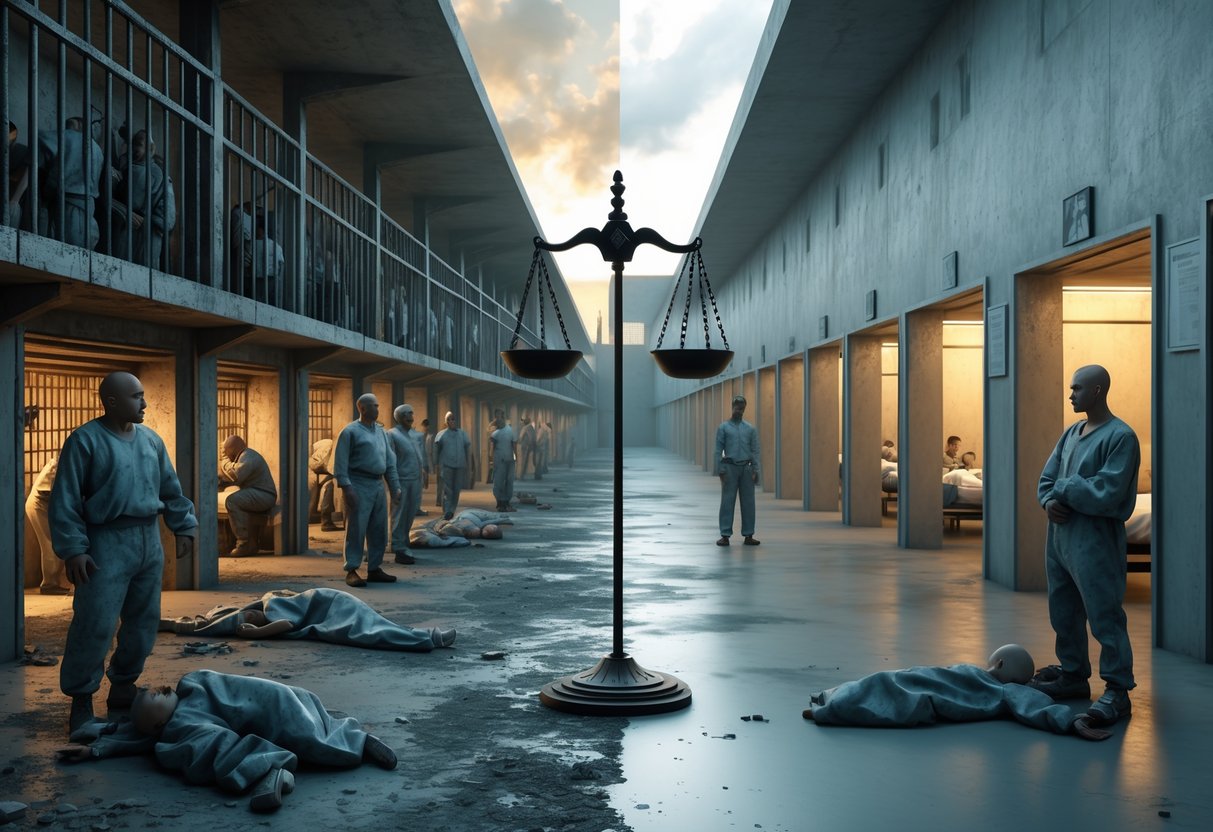
Prisons around the world treat inmates very differently. Some focus on dignity and rehabilitation, while others are overcrowded and lack basics. Solitary confinement rules swing from tightly controlled to endless isolation, and healthcare access is all over the map.
Prison Conditions Worldwide
Prison conditions reflect each society’s values. Some countries try to rehabilitate, others stick to punishment.
Nordic Model vs Traditional Systems
Norway’s Halden Prison is famous for its human dignity approach. Inmates get private rooms with doors and bathrooms. They cook together and have vocational training.
Violence barely happens there. Staff build supportive relationships, not just enforce rules.
Challenging Conditions Globally
Many prison systems deal with overcrowding and dirty conditions. Clean water and basic medical care can be hard to find.
The US focuses on “custody and order.” Security measures like strip searches, handcuffing, and lockdowns are common. Idleness fills much of the day.
Key Factors Affecting Conditions:
- Overcrowding – cuts access to programmes, ups tension
- Staff training – shapes inmate-officer relationships
- Funding – affects healthcare, food, and facilities
- Legal rules – set minimum standards and oversight
Solitary Confinement Practices
Countries treat solitary confinement in very different ways. Their approach reveals a lot about their philosophy.
Restrictive vs Punitive Use
Norway caps punitive solitary confinement at 8 hours. They try less restrictive punishments first, like limiting money, property, or leisure.
The US uses solitary a lot more. Inmates can land in isolation for minor stuff like talking back. Some people spend years there.
International Standards
The UN says solitary over 15 days counts as torture. Still, many countries break this rule.
Common Triggers for Solitary:
- Inmate violence
- Threats to staff
- Gang activity
- Protecting vulnerable prisoners
European prisons usually try alternatives like counselling, mediation, or taking away privileges instead of isolating people.
Access to Healthcare and Basic Rights
Healthcare in prisons really shows how countries value basic rights.
Healthcare Standards
Good systems offer medical care equal to what’s available outside. That means mental health services, dental care, and help for chronic issues.
But many prisons lack enough medical resources. People with disabilities or special needs often suffer most.
Basic Rights Provision:
- Clean water and sanitation – not always available
- Nutritious food – ranges from great to barely edible
- Family contact – from regular visits to almost none
- Education – key for reintegration, but not always offered
Vulnerable Populations
Women, young offenders, and minorities face extra challenges. Indigenous people often deal with discrimination.
Mental health care is especially underfunded. Many inmates with psychological issues get little help, making reintegration even harder.
Alternatives to Incarceration
Modern correctional systems lean more on community-based punishments. These keep offenders out of prison but still hold them accountable. The focus shifts to supervision, monitoring, and helping people contribute to their communities, not just locking them up.
Probation and Community Supervision
Probation lets convicted people serve their sentences in the community, but under close watch. Honestly, it’s the most common alternative to prison in developed countries.
Standard probation means regular meetings with probation officers. Offenders have to stick to rules—like staying in certain areas or avoiding specific people. Usually, probation lasts six months to three years.
Intensive supervision probation ramps things up with more check-ins and tighter controls. Officers might drop by unannounced or call every day. This works best for higher-risk offenders who need extra oversight.
Community supervision usually includes:
- Weekly or monthly officer meetings
- Mandatory drug tests
- Job requirements
- Curfews
- Required treatment programmes
Probation costs about £3,000 per person each year. Prison? That’s closer to £40,000. Studies show that 60-70% of people on probation finish their sentences without big violations.
Staffing remains a key hurdle. Many probation services deal with heavy caseloads, which makes real supervision tough.
Electronic Monitoring
Electronic monitoring tracks offenders’ locations using GPS tech, and honestly, it’s catching on quickly around the world.
GPS ankle monitors send real-time location updates to supervision centres. Courts can set up zones—like keeping offenders away from victims’ homes or places like bars or schools. If someone steps out of bounds, the system sends alerts right away.
Radio frequency monitoring works differently. It checks if someone leaves their approved spot, which fits house arrest situations where people need to stay home except for work or medical needs.
Modern systems usually cover:
- 24/7 tracking
- Instant alerts for boundary breaks
- Alcohol detection
- Two-way communication
- Battery status updates
Using electronic monitoring costs about £20 a day, way less than the £110 for prison. Around 15,000 people in England and Wales use these devices each year.
Still, there are problems—technical glitches, false alarms, and the stigma of wearing a visible ankle monitor. Some folks say finding a job gets harder when employers see the device.
Community Service Schemes
Community service means offenders do unpaid work that helps the local area. For property crimes and minor offences, this approach just makes sense.
Typical projects might be:
- Cleaning parks or picking up litter
- Helping in charity shops
- Supporting elderly care
- Lending a hand at youth centres
- Working on environmental restoration
Courts usually order between 40 and 300 hours. Offenders spread this work out over several months, mostly on weekends. Supervisors check attendance and make sure the work gets done right, while also offering support.
The benefits go beyond punishment. People pick up job skills, build work habits, and form community connections. Many say they feel more confident and find purpose by giving back.
Community service runs on a tight budget. Main costs are for supervisors and transport. Meanwhile, communities get real help and offenders get a chance to make things right.
But there are hurdles. Finding enough placements, keeping track of attendance, and making sure everyone stays safe aren’t easy. Some organisations just aren’t comfortable taking on offenders, so opportunities can be limited.
Research suggests community service cuts reoffending by about 10% compared to short prison sentences. The mix of accountability, skill-building, and community ties really helps most people.
Rehabilitation and Reintegration Programmes
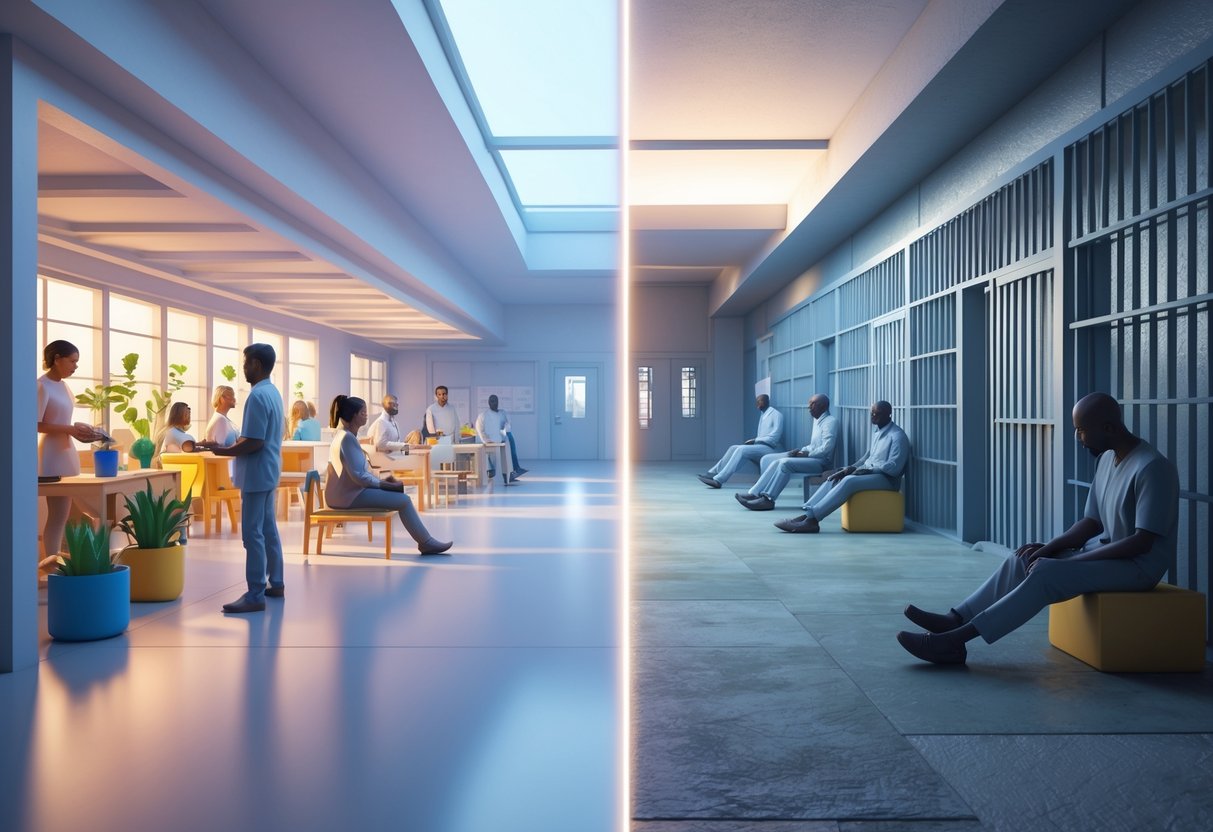
Modern prison systems now put more effort into preparing offenders for life after release. These programmes aim to fill skill gaps, address mental health needs, and help with education—areas that often get overlooked.
Vocational Training in Correctional Settings
Vocational training teaches practical skills for real jobs after release. Programmes often cover carpentry, plumbing, car repair, and food service.
Facilities run these programmes with help from local businesses and trade groups. Inmates can earn industry-recognised certificates while serving time.
Key benefits:
- Better job prospects after release
- Lower risk of reoffending
- Building work habits and routines
Studies show inmates with vocational training reoffend 13% less than those without it. Programmes last anywhere from six to eighteen months, depending on the skill.
Many prisons now add training in IT support, warehouse work, and customer service. These fields tend to hire former offenders who’ve got the right credentials.
Mental Health Support Services
Mental health programmes tackle the psychological issues behind crime. Nearly 70% of prisoners have mental health conditions that need treatment.
Services include one-on-one counselling, group therapy, and managing psychiatric medication. Cognitive behavioural therapy helps inmates spot and change harmful thought patterns.
Core elements:
- Substance abuse treatment for addiction
- Anger management to build emotional control
- Trauma counselling to process past experiences
Peer support programmes let inmates who are further along mentor newcomers, which helps build community and accountability.
Crisis intervention teams step in during emergencies. Trained staff keep an eye on high-risk individuals and coordinate care.
Educational Opportunities
Prison education covers everything from basic literacy to university-level courses. Many people enter prison with little formal education, so these programmes are crucial.
Basic classes focus on reading, writing, and maths. Adult education helps inmates earn GCSEs or similar qualifications.
Some prisons team up with universities for degree courses. Others offer distance learning or online classes under supervision.
Popular subjects:
- Business studies
- Social work
- Creative writing
- Computer literacy
Libraries and study areas give inmates space to learn. Many facilities allow tablets or computers, but only for education.
Peer tutoring lets more educated inmates help others. It’s a chance for positive leadership inside the prison.
Recidivism: Measurement and Prevention
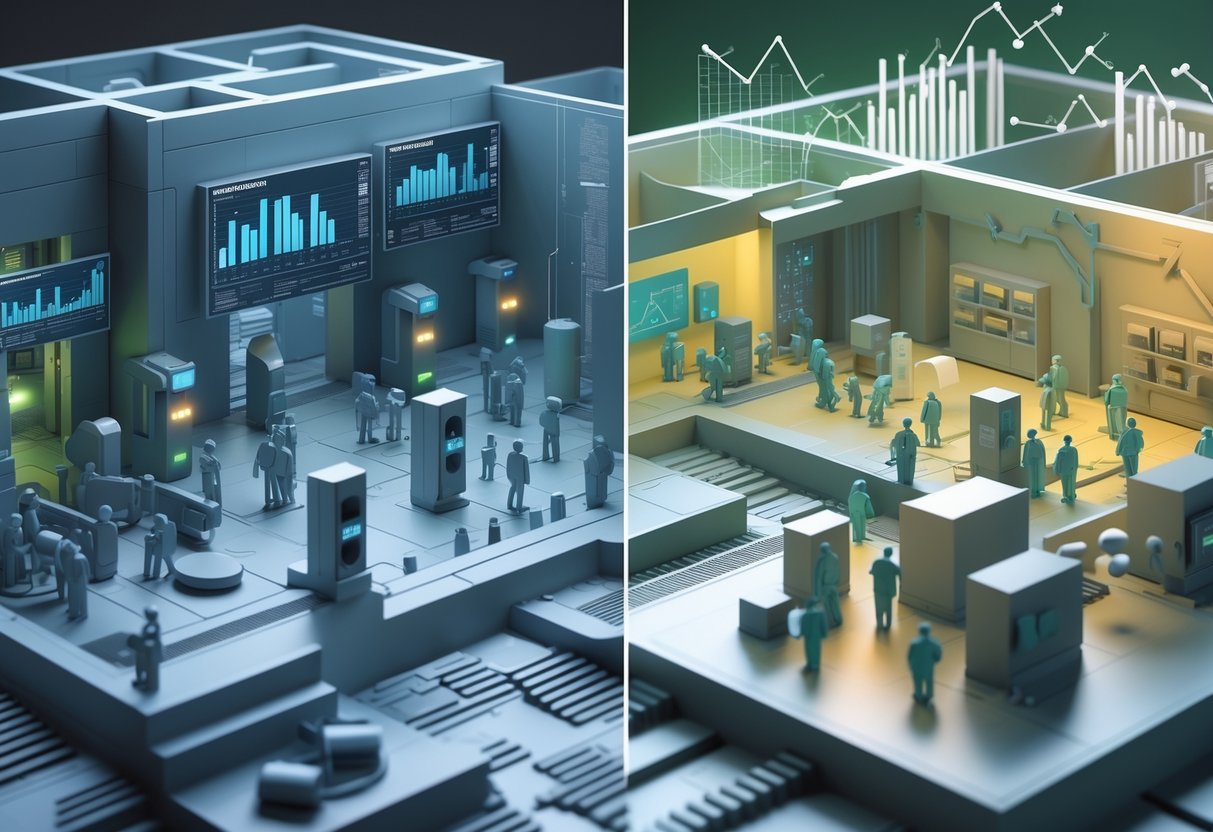
Recidivism rates swing wildly between countries. Systems that focus on rehabilitation see much lower reoffending than those that stick to punishment. Real prevention means starting early, offering vocational training, and actually measuring what works.
Recidivism Rates Across Countries
Global data paints a pretty clear picture—countries with different philosophies get very different results. Norway, for example, keeps youth reoffending at just 12%, while systems that lean on incarceration can see rates over 50%.
A quick look:
| Country | Youth Recidivism Rate | Primary Approach |
|---|---|---|
| Norway | 12% | Rehabilitation |
| Germany | 30% | Vocational training |
| Finland | 15% | Early intervention |
| New Zealand | 28% | Restorative justice |
Measuring recidivism isn’t simple, though. Countries use different timeframes—Japan checks over one year, Germany uses three. That makes apples-to-apples comparisons tricky.
Definitions also differ. Some count any new arrest, others only serious convictions.
These measurement issues really mess with policy decisions. Without standard metrics, it’s hard to know which approaches truly work.
Effectiveness of Rehabilitation
Rehabilitation programmes beat pure punishment when it comes to reducing reoffending. Germany’s job support model makes that obvious—offenders with employment help reoffend at 22%, compared to 53% without.
Education matters a lot. Young offenders who finish secondary education in the system are much less likely to come back.
What works:
- Vocational training—Germany teams up with over 2,000 employers
- Mental health support—Norway keeps psychologists on-site
- Family involvement—New Zealand brings families into the process
- Substance abuse treatment—Finland uses trauma-informed care
Early intervention is crucial. Finland diverts 91% of cases to social workers before court, stopping criminal records from forming and opening up future opportunities.
But rehabilitation needs steady funding. Scotland’s 2024 reforms put £18 million a year into community mental health, betting that upfront spending saves money by cutting reoffending later.
Role of Diversion Programmes
Diversion programmes steer offenders away from court and into treatment, school, or community service. These alternatives avoid criminal records and tackle root causes.
The Netherlands leads the way here. Local prevention teams use risk algorithms to spot at-risk youth. Rotterdam’s pilot cut crime by 31% among those flagged.
Common approaches:
- Community service orders supervised by neighbourhood councils
- Restorative justice meetings for victims and offenders
- Education mapping to help kids stay in school
- Family counselling to fix home issues
Quick action is key. Finland requires family counselling within 72 hours of arrest to keep cases out of the formal system.
Digital monitoring is replacing detention more and more. GPS and curfew systems let people stay in their communities while making sure they follow the rules.
The big challenge? Picking the right cases. Serious violent crimes usually go through court, while property and first-time offences fit diversion better. Clear guidelines keep things fair and effective.
Comparative Analysis: United States vs. Other Countries

The United States runs one of the world’s most punishment-heavy justice systems. In contrast, many European and Nordic countries focus on rehabilitation and restorative justice. These different mindsets have led to big gaps in incarceration, recidivism, and even public safety.
United States and Incarceration
The US locks up more people than anywhere else—over 2 million right now. This comes from decades of “tough on crime” laws and the war on drugs that started in the 1970s.
Main features:
- Mandatory minimums
- Three-strikes rules
- Private prisons
- Long sentences for drug crimes
The American system puts punishment and deterrence first. Sentences tend to be much longer than in other developed countries.
This approach has serious downsides. About 68% of released offenders go back to prison within three years. Since rehabilitation takes a back seat, people often get stuck in a cycle.
The war on drugs especially drove up prison numbers. Non-violent drug crimes can mean long sentences, which leads to overcrowding and hits minority communities hardest.
European Penal Models
European countries usually lean toward rehabilitation. Germany, France, and the Netherlands show this with shorter sentences and strong support programmes.
What’s typical:
- Education and job training for inmates
- Gradual release systems
- Community service as an alternative
- Restorative justice practices
Prisons in Europe often look more like dorms than cells. Inmates follow daily routines with work, learning, and therapy.
Recidivism rates stay lower than in the US. Germany’s is about 46%, and France is in the same ballpark.
Europe also spends less per prisoner each year. Instead of long sentences, they invest in prevention and community support.
Still, public opinion can turn against these approaches after high-profile crimes.
Nordic Systems and Restorative Justice
Nordic countries—think Norway, Sweden, Denmark—take the most progressive approach out there. Norway’s recidivism rate is just 20%, showing how well rehabilitation can work.
- Open prisons with little security
- Victim-offender mediation
- Therapeutic prison communities
- Strong post-release support
Norwegian prisons look more like college campuses. Inmates get private rooms, cook their meals, and spend time on work or education.
The philosophy is all about dignity and fixing root causes. Mental health care, addiction treatment, and job training are part of daily life.
These countries prove that treating people humanely doesn’t hurt public safety. In fact, they have some of the lowest crime rates and best rehabilitation outcomes in the world.
Cost per prisoner looks high at first, but lower reoffending saves money in the long run.
Private vs. Public Correctional Systems
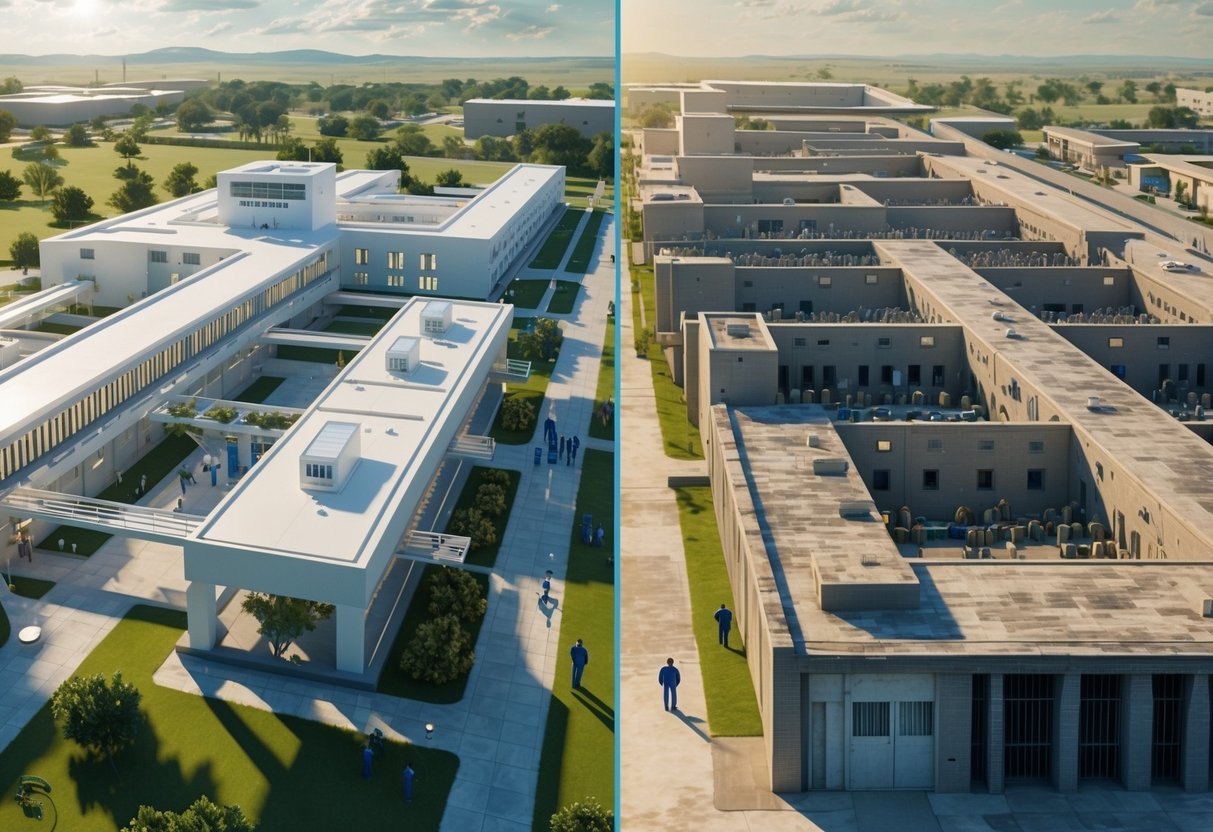
Private prisons are run by companies for profit, while public prisons are managed by government agencies. The biggest differences show up in how they’re funded, who they accept, and how they’re held accountable.
Private Prisons: Pros and Cons
Private correctional systems popped up in the 1980s, right in the middle of America’s War on Drugs. Today, they house about 8% of the US prison population.
Main advantages include:
- Lower operating costs per inmate
- Less government spending on building prisons
- Quicker facility development
Significant drawbacks involve:
- More violence and assaults
- Less training for correctional officers
- Profit motives that discourage rehabilitation
Private prisons make money based on how many beds they fill. Many contracts actually require a minimum number of inmates, or else the company faces penalty fees.
This setup encourages keeping prison populations high, not reducing crime.
These facilities often turn away inmates with expensive medical or mental health needs. They usually take non-violent drug offenders who need less security.
Public prisons, on the other hand, have to accept all inmates assigned by the government.
Officers in private prisons get about 58 hours less training than those in public ones. Employee turnover is three times higher in private facilities than in government-run ones.
Oversight and Accountability
Public prisons report detailed info about spending, staffing, and daily operations. Taxpayers can access this data through freedom of information requests.
Private facilities dodge a lot of this scrutiny. They’re not required to show how they spend government contract money. Many don’t report stats on solitary confinement or violence.
Key accountability differences:
| Public Prisons | Private Prisons |
|---|---|
| Full financial transparency | Limited disclosure |
| Government oversight | Minimal regulation |
| Public records access | Corporate confidentiality |
Government agencies keep a close eye on public prison conditions. Private facilities mostly answer to corporate shareholders, not public officials.
The Justice Department found that private prisons are more dangerous and do a worse job at rehabilitation. Still, policies on their use swing back and forth depending on who’s in charge politically.
Impact on Outcomes
Private prisons tend to have worse results by a lot of measures. Violent incidents happen 49% more often than in public facilities.
Inmate-on-inmate assaults are 65% more frequent in private prisons.
Rehabilitation programs in private systems just don’t measure up. Public prisons offer more education, mental health services, and job training.
Private facilities focus on cutting costs, not preparing people for release.
Average sentence length is more than double in private prisons. That suggests these companies profit by keeping people locked up longer.
Recidivism rates are still a problem in both systems. But public prisons put more money into programs that actually cut down on reoffending—things like drug treatment, literacy classes, and vocational training.
Private prison companies made over £4 billion in 2016.
Critics say this profit motive clashes with public safety and criminal justice reform.
Youth and Special Populations Within Punishment Systems
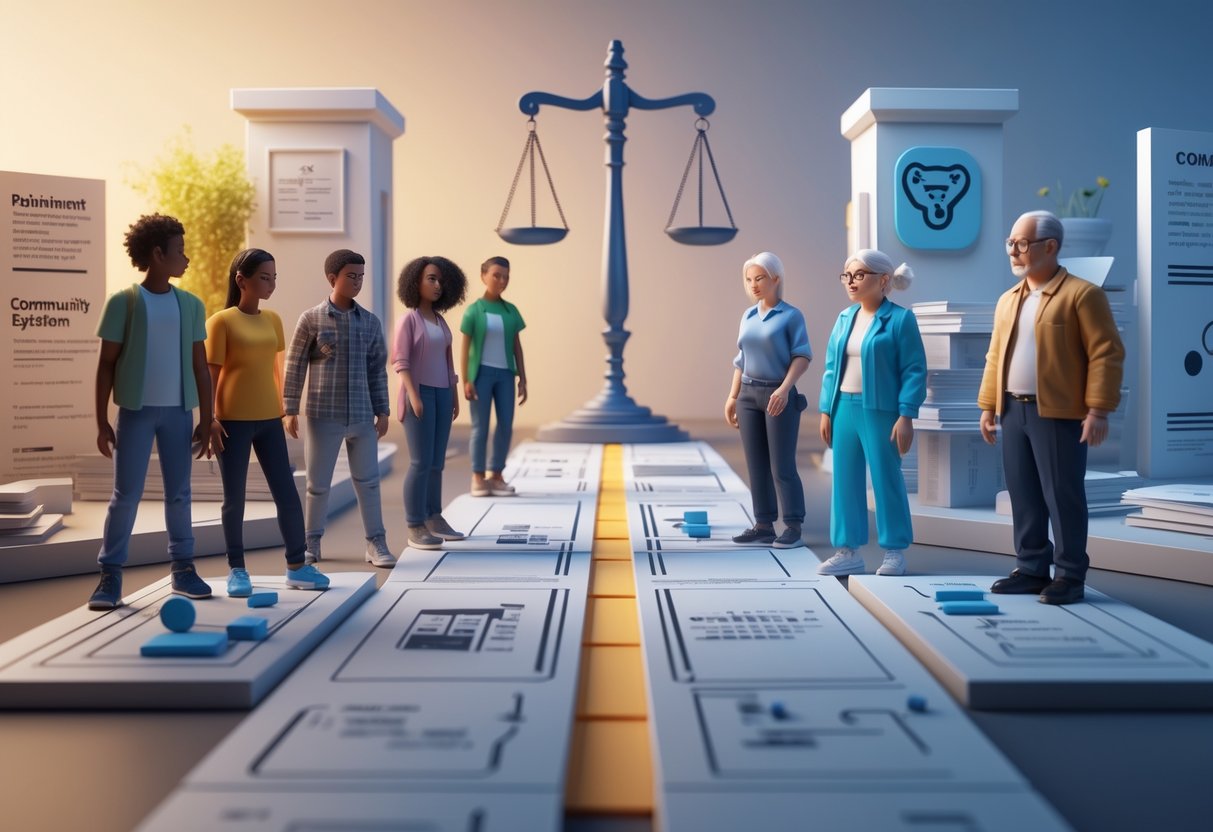
Young offenders and vulnerable populations face a different set of challenges in punishment systems. Juvenile courts often focus on rehabilitation, but correctional facilities struggle to address trauma and mental health needs.
Gender and racial disparities make things even harder, seriously affecting outcomes.
Juvenile Justice Approaches
Most systems keep youth separate from adults by using juvenile courts. These courts usually aim for rehabilitation over punishment.
In the UK, the juvenile system handles offenders aged 10-17 with Youth Offending Teams. These teams mix social workers, probation officers, and mental health specialists.
Key differences from adult systems:
- Shorter sentences
- Family involvement in proceedings
- Education during detention
- Focus on preventing reoffending
Some US states, though, try youth as adults for serious crimes. This “adult transfer” puts young people into adult prisons.
The data is pretty grim. About one million US youth get arrested every year, and Black youth face arrest at twice the rate of white youth.
Germany takes a different approach. They have Europe’s lowest youth incarceration rate, with only 593 juvenile inmates in 2021. Their system focuses on community-based interventions.
Juvenile facilities cost about £250 per day per young person. Yet, research keeps showing that traditional interventions don’t do much to prevent future offending.
Treatment of High-Need Individuals
Correctional facilities now house more people with mental illness, addiction, and developmental disabilities than ever before. Most systems just aren’t set up to provide the specialized care these folks need.
Mental health needs hit youth especially hard. Studies reveal high rates of trauma, depression, and anxiety disorders among juveniles.
Common challenges include:
- Not enough mental health staff
- Weak substance abuse programs
- Little support for developmental disabilities
- Poor links to community services
The “school-to-prison pipeline” especially hurts vulnerable youth. Zero-tolerance policies in schools mean kids get arrested for minor stuff. Around 20,000 police officers now work in US schools.
Many young people land in the system after abuse or neglect. The “sexual abuse to prison pipeline” refers to girls being criminalized for survival behaviors.
Status offenses like truancy are another problem. These are only crimes because of the person’s age. About a quarter of confined youth haven’t even been charged with actual crimes.
Technical violations make things worse. Youth on probation can get locked up again just for breaking complicated rules.
Gender and Minority Experiences
Women and ethnic minorities face unique challenges in punishment systems. These gaps mirror wider social inequalities.
Gender differences in juvenile justice:
| Factor | Males | Females |
|---|---|---|
| Most common charges | Property crimes | Family violence offences |
| Pathway to system | Peer-related incidents | Domestic situations |
| Treatment focus | Anger management | Trauma therapy |
Girls are getting charged more often for family disputes. Minor fights with parents get “re-labelled” as assault charges. This has pushed up female juvenile arrest rates.
Black girls get harsher treatment. They’re more likely to be tried as adults and get longer sentences than white peers for the same offenses.
Racial disparities show up everywhere. Black youth are locked up at rates four to five times higher than white youth. Native American youth also face disproportionate incarceration.
LGBTQ+ youth deal with extra barriers. They’re overrepresented in juvenile systems, often after family rejection leads to homelessness and survival crimes.
These gaps don’t disappear in adult systems. Women of color now face the highest rates of incarceration growth, which hits families and communities across generations.
Research points out that tackling trauma, offering culturally relevant programs, and keeping kids out of the system works better than old-school punishment.
Current Debates and Reforms in Punishment Systems

Prison systems everywhere feel the heat to balance human rights with public safety. Reformers push for more rehabilitation, while politicians often lean toward tougher sentencing to calm crime fears.
Global Penal Reform Movements
Big changes are happening in how countries view their prisons. A lot of nations now admit that just punishing people doesn’t really cut reoffending rates.
Nordic countries are way ahead here. Norway’s prison system puts rehabilitation front and center. Their reoffending rate? Just 20%, compared to 68% in more punitive places.
Several European countries have scrapped life sentences without parole. They say these go against human rights. Germany and many Scandinavian countries now cap sentences at 15-20 years.
In the US, eight states got rid of constitutional language allowing prison slavery in 2024. Nevada joined Alabama, Colorado, and others in banning forced labor for prisoners.
Key reform areas include:
- Ending solitary confinement for vulnerable people
- Improving prison conditions and healthcare
- Expanding educational programs
- Building better reintegration support
International groups like the UN set minimum standards. The Nelson Mandela Rules guide global prisoner treatment, but enforcement is still all over the place.
Reducing Prison Populations
Prison overcrowding is a worldwide headache. Countries are trying different ways to fix it while still keeping people safe.
Sentencing reforms are making a difference. In 2024, Oklahoma passed a law letting domestic violence survivors seek reduced sentences. Michigan expanded medical parole for older and sick prisoners.
Alternative programs are catching on. Electronic monitoring lets some serve sentences at home. Drug courts send addiction cases to treatment instead of prison.
Some reforms hit political walls. California voters approved tougher penalties for property crimes in 2024, rolling back earlier sentence reductions.
Successful reduction strategies:
- Second-look policies – reviewing long sentences after a set time
- Compassionate release – early release for elderly or ill prisoners
- Diversion programs – treatment instead of prison for addiction
- Bail reform – cutting down on pre-trial detention
A few states got rid of automatic adult charges for young offenders. Indiana dropped mandatory adult prosecution for youth handgun offenses, keeping more cases in juvenile courts focused on rehabilitation.
Balancing Punishment and Prevention
The tug-of-war between punishment and rehabilitation shapes criminal justice policy everywhere. There’s real tension between public calls for tough sentences and the evidence that rehabilitation works better.
Rehabilitation programs get better results. Prisoners who finish education or job training are less likely to reoffend. These programs also cost less than long-term incarceration.
Political pressure often pushes for punishment. Crime spikes during the pandemic led to harsher talk from leaders. Voters sometimes pick tougher sentences, even if crime rates are dropping.
Employment barriers are still a huge problem. People with records struggle to get jobs after release. Arizona, Colorado, and Virginia passed laws in 2024 cutting licensing restrictions for former offenders.
Restoring voting rights is gaining steam. Nebraska ended waiting periods for voting after finishing a sentence, giving about 7,000 people their rights back.
Effective balance needs:
- Evidence-based sentencing rules
- More investment in prison education
- Stronger reintegration support
- Community alternatives to custody
Youth justice looks especially promising for reform. Adolescent brains just work differently than adults’. Pennsylvania now requires regular reviews for youth in custody, aiming to shorten detention times.
Frequently Asked Questions
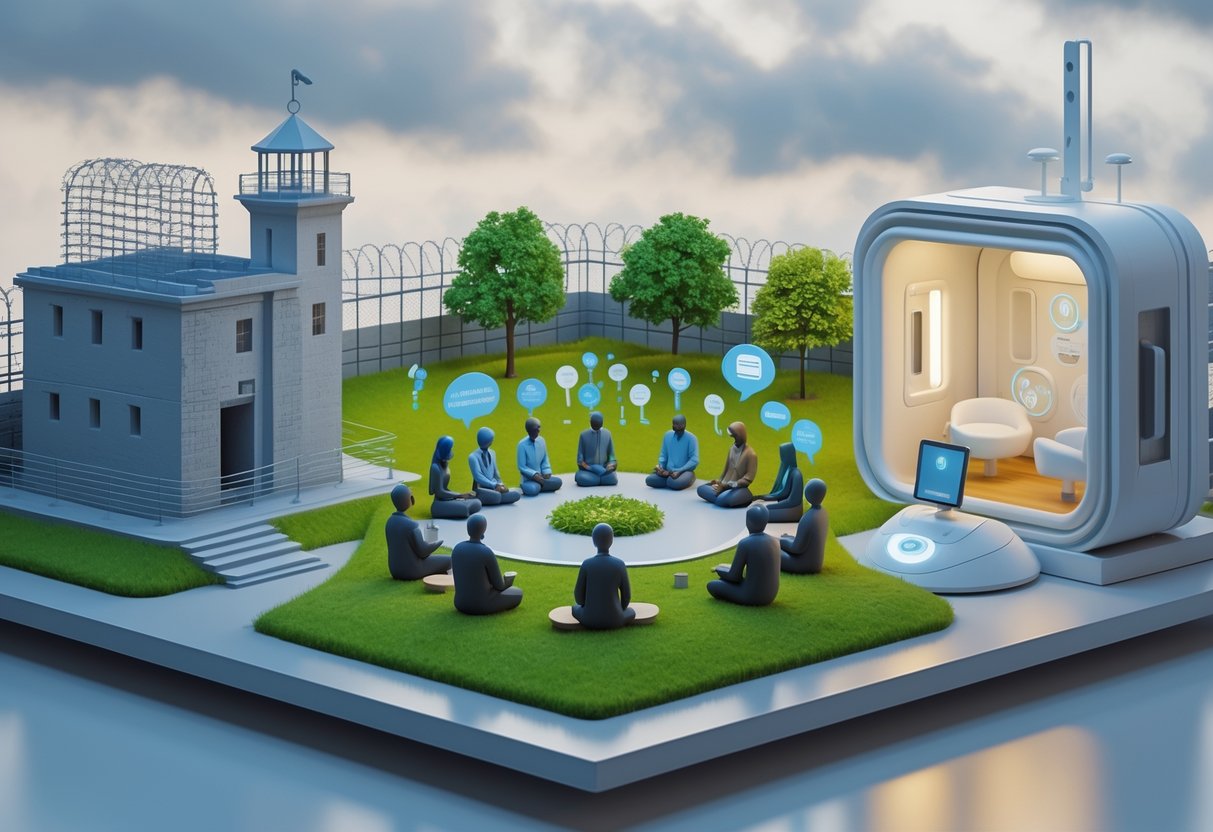
Punishment systems around the globe handle justice, rehabilitation, and deterrence in wildly different ways. These systems reflect cultural values and legal philosophies unique to each society.
What are the main differences between restorative justice and traditional sentencing methods?
Traditional sentencing relies on punishment—prison, fines, that sort of thing. The idea is to make offenders pay for their crimes with consequences.
Restorative justice takes a different tack. It brings together victims, offenders, and community members to address harm and focus on healing.
Traditional methods usually separate offenders from society by locking them up. This approach leans on deterrence and retribution. Courts decide sentences based on rules and past cases.
Restorative practices make offenders take responsibility in person. They meet the people they’ve harmed and work to put things right. That could mean community service, paying compensation, or other agreed actions.
The traditional system runs cases through formal courtrooms, with judges and lawyers calling the shots. Victims rarely get much say in what happens.
Restorative justice lets victims speak up. They explain how the crime affected them and help shape what the offender should do to repair the harm.
Could you explain the pros and cons of using a punitive system versus a rehabilitation-focused approach for offenders?
Punitive systems deliver clear consequences for crime. They send a strong message about what society won’t tolerate. Many victims feel justice is done when offenders get tough penalties.
But punitive approaches don’t do much to cut reoffending. High prison populations cost taxpayers a lot. Offenders often leave prison without skills or support to restart their lives.
Rehabilitation-focused systems tackle the root causes of crime. They offer education, job training, and mental health support. Norway, for example, shows these methods can seriously lower recidivism.
Still, rehabilitation can look “soft” to victims and the public. It takes a lot of upfront investment in programs and facilities. Results don’t happen overnight.
Punitive systems offer quick satisfaction but don’t fix much long-term. Rehabilitation systems get better results, but require patience and public buy-in. Most countries now try to mix both for a better balance.
How do different cultures approach the concept of punishment and rehabilitation in their justice systems?
Western countries, like the United States, lean heavily on retribution and deterrence. High prison populations there seem to show a belief that tough sentences stop crime.
Several US states still keep the death penalty on the books.
Nordic countries, on the other hand, put rehabilitation first. Norway, for example, designs comfortable prison conditions to help inmates prepare for a successful return to society.
They treat crime more as a social problem that needs healing, not just punishment.
Islamic legal systems mix retribution with chances for forgiveness. In Saudi Arabia, strict Sharia law penalties exist, but victim families can pardon offenders.
That blend of justice and mercy really reflects deep cultural values.
Asian countries, like Japan, focus on confession and community shame. Offenders are expected to take responsibility and show genuine remorse.
Community-based rehabilitation helps people rebuild social ties after serving their time.
African traditional justice systems usually aim to restore community harmony. They gather everyone involved to address the wrong and find a way forward.
Sometimes, compensation or ritual cleansing steps in instead of formal punishment.
All these differences make it clear—no single approach works for every society. Each system really comes from its own ideas about justice, forgiveness, and what keeps society together.
What impact does each type of punishment system have on recidivism rates?
Punitive systems often end up with higher reoffending rates. In the United States, about 68% of released prisoners get arrested again within three years.
Harsh prison conditions and a lack of support seem to fuel this cycle.
Countries that focus on rehabilitation usually see much lower recidivism. Norway, for instance, reports only 20% of offenders commit new crimes within two years.
Their focus on education and job training really seems to help.
Restorative justice programs offer some hope, especially for young offenders and minor crimes. Face-to-face meetings with victims can sometimes spark real change.
Countries that mix punishment with rehabilitation, like Germany, find a middle ground. They balance accountability with skill-building, and their recidivism rates land somewhere in between.
Community-based sentences tend to work better than prison time. Electronic monitoring and supervised release cost less and let people keep family and job ties.
That support can make all the difference in staying out of trouble.
Despite the evidence in favor of rehabilitation, public opinion and politics often push for tougher sentences—even when the outcomes aren’t great.
In what ways do modern punishment philosophies account for juvenile offenders compared to adult offenders?
Juvenile justice systems understand that young brains just work differently. Most countries keep youth courts separate from adult ones.
The focus shifts more toward guidance and education instead of punishment.
Young offenders usually get shorter sentences than adults for the same crimes. Courts look at family background, school performance, and other factors.
The main goal is to help kids turn their lives around, not just punish them.
Rehabilitation programs for youth build skills and offer counseling. Many systems also provide education, job training, and mentoring.
Family involvement often makes a big difference in these plans.
Adult systems, meanwhile, put more weight on accountability and public safety. Sentences reflect full criminal responsibility, and while rehab options exist, punishment usually comes first.
Sometimes, though, serious juvenile crimes wind up in adult court. Murder, sexual assault, and repeat violent offenses might trigger an adult transfer.
These decisions spark plenty of debate and vary depending on where you are.
Modern approaches now recognize that juvenile brains keep developing until about age 25. This science is starting to shape sentencing and treatment.
There’s a definite trend toward more rehabilitation for young offenders, though it’s still evolving.
Can you outline how technology has influenced the evolution of punishment systems in recent years?
Electronic monitoring has really changed community-based sentences. GPS ankle bracelets let offenders serve time at home and even keep their jobs.
This approach saves prison costs and helps families stay together.
Digital communication tools have made probation supervision easier to manage. Officers now use video calls and messaging apps to check in more often.
Offenders can share updates and talk about challenges more frequently than in the old days of monthly meetings.
Data analytics now help predict who might reoffend with more accuracy. Algorithms look at things like criminal history, employment, and social ties.
Courts rely on these assessments to pick the right sentences and decide how much supervision someone needs.
Online education platforms have opened up more options for rehabilitation. Prisoners can get degrees or job training using tablets and computers.
They can keep learning after release, which feels like a big step forward.
Virtual reality therapy is starting to tackle specific criminal behaviors. Some programs help violent offenders work on empathy or anger management.
Sex offender treatment sometimes uses VR to practice safe social interactions.
Still, technology brings up some tough privacy and bias issues. Monitoring systems track people’s movements and conversations a lot.
Algorithmic assessments sometimes pick up on old patterns of discrimination in policing and sentencing.
Honestly, the balance between public safety and personal privacy is still shifting. Technology gives us powerful tools for both punishment and rehabilitation, but it’s not always simple to use them right.

